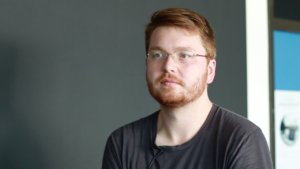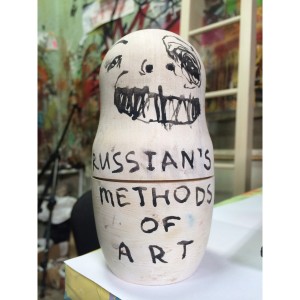So, a lot of my work deals with a lot of, I’d say the interstitial spaces between either virtual and physical space or just different modes of representation and even, I’d say content creation, I guess. For a long time, I’ve been invested in trying to make works that either, in some cases – depending on the series – live very much between kind of an intangible object and a very tangible object and kind of questioning the distinctions and boundaries between those. Whether that’s through challenging kind of modes of image production or whether that is working with how things like intellectual property control the production and distribution of objects, basically. Most recently, I suppose, I stand in[?] some of that inquiry into an augmented reality app that is an extension of one of my main series which is called Image Objects. So the app is called Image Objects and it’s kind of like an augmented reality camera app experience that you can – it’s like a free download on the iOs store, you can load it up and use this face of the camera of the phone to analyze the space around you and place fragments of images in space around you that kind of, I suppose, behave like objects, you can walk around them and through them and experience kind of the way that my work functions usually on a representational level and the space of the installation, the[?] ideas for my work, but in physical space.
The Image Object in that nomenclature basically was just the idea of kind of the funda- like the fundamental way that we deal with, with images and objects in – I’d say like – culture today or just as individuals. The way that – the way that for example we can know an object and know a space through images and representations of reality[?] today. And how in fact those venues which we traditionally think of venues of representation, for example, like the division between what we had called primary information, like the actual experience of a thing, versus what we would call secondary information, the representation or the mediated image, or something other than image, I suppose, of a thing. How those categories can either become collapsed or the, I guess, the possibilities that are there when we think of those things, those kind of extensions of each other. One of the things that, I think, drives me really frequently, is trying to understand the artwork as this kind of like piece of media, mediatized object-image, image-object, I guess. That, that can’t exist outside of the boundaries of, can’t the rest of society or culture, I suppose. This, I’d say, is one of the reasons that led me [unintelligible] to work on – to work with intellectual property because that was out of an interest in, you know, all things being equal, for example. The domain of intellectual property is kind of the almost like juridical technology, basically, but produces our ability to – how do I put it – to like own ideas, though technically, obviously, intellectual property governs everything, except for the idea. But the idea of kind of like producing again that kind of like hybrid object that exists between multiple states but then is protected by this juridical function, for example, which says that I as a producer created this product and thus it is my intellectual property. That’s something that I think probably interests me, because of its kind of broader social implications for where we are and where we might be going. Throughout, whether you like think of it in the direct term of the, something like intellectual property, which is an example. A lot of what drives me, I think, is the – an interest in kind of disentangeling propriety or – how do I put it – propriety, originality, authenticity, basically, which are things that I think we think of as arriving kind of like sui generis into, into the world or into culture but which very much are these social, technological and juridical constructs, basically.

















